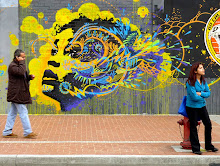If you have not seen the Fountain, then you are most likely deprived of channeling the ultimate possible awareness of our position in the galaxy. Those who have seen it are usually displeased by the plot, because it is too enigmatic. That's simply because there is nobody on hand who can explain the concepts in the film. The concepts in the movie are extremely transcendental, and it requires the widest possible scope of this spiritual science to fully decipher. This 2006 Darren Aronofsky epic directly translates to the concepts already discussed in this blog, especially in the realm of Alan Moore. In the graphic novel Watchmen, Professor Manhattan is the superhero with ultimate capabilities in the spectrum of matter and time. He sees everything as happening simultaneously, exactly the way the fourth dimension contains all of time at once (see the third post about Alan Moore's "From Hell"). Edwin A. Abott, noted Shakespearean scholar, wrote the mind-blowing tale about the second, third and fourth dimension called Flatland.
What makes the The Fountain transcendental?
1. Three planes of time happening at once: the Conquistador crusades in Mexico, the modern day, and a timeless bubble through eternity. Hugh Jackman and Rachel Weisz's characters appear as different entities in all three. In the bubble through eternity, Rachel Weisz is represented as a tree, from which her character in the modern day time spectrum fertilized with her dead body.
2. Hugh Jackman seeks to scientifically cure any disease that kills humans through genetic technology. He is bitter and ruthless in his desire to find the cure to death in the modern day scenes, only to undergo intense spiritual transformations in the conquistador and bubble time frames. Before dying and being reborn in the first timeframe as a conquistador, he is killed by the Mayan Lord of Xibalba who says "Death is the road to awe." This becomes the book that Rachel Weisz's character writes in modern day and gives to Hugh Jackman to finish.
3. According to the IMDB trivia, "Instead of using CGI, Aronofsky chose to do the special effects for the film by using micro-photography of chemical reactions on tiny petri dishes. He has said that CGI would take away from the timelessness of the film and that he wants the film to stand the test of time."
4. The death and rebirth of characters mirrors the Hindu / Buddhist concept called Samsara which refers to a stream of consciousness passing from the physical world and into the spiritual upon death, and that is the concept of immortality that Hugh Jackman realizes is even more powerful than living. When he understands this toward the end of the movie, the camera pans to the middle of his forehead, where his third eye is seated, and he then sees everything happen at once.
Point number 4 directly relates to the Pink Floyd title track off the album "Atom Heart Mother." As the song unfolds, an interesting blend of sound effects foreshadows the type of sounds in the 24 minute song. About 20 minutes into the song, the song replays itself in a sped-up backwards fashion that contorts reality. This section of the song is called "Remergence." Also the same concept as Alex Grey's representation of the soul's ultimate evolution:
"Death is the road to awe" is truly applicable to both life and death, since both are interconnected.
Aronofsky also defines the blueprints to our material world with his first movie, Pi. In Pi, the greatest concept is that of nature's perfect geometry. Desperately seeking to understand the patterns of the stock market, Max goes beyond the edge of his human experience to understand, albeit briefly, the ultimate relationships between spiral conch shells, ants, and the entire universe. Panning between shots in The Fountain, Aronofsky blends nature with greater images of the universe. Professor Tim Allen, at UW-Madison, also uses this concept to teach "Plants and Man," his famed class on rethinking our universe. Manly Hall writes:
"...Man himself, with in the narrow confines of whose nature they found manifested all the mysteries of the external spheres. Continuing this analogy, the universe was regarded as a man and, conversely, man as a miniature
universe. The greater universe was termed the Macrocosm--the Great World or Body--and the Divine Life or spiritual entity controlling its functions was called the Macroprosophus. Man's body, or the individual human universe, was termed the Microcosm, and the Divine Life or spiritual entity controlling its functions was called the Microprosophus."
This is a real doctrine of learning! The Occult aspect of society has been exactly that - hidden - and now the real identity of our spiritual selves is emerging to all through great researchers of our time like David Icke. If you enjoy the Occult, you should start by watching the very informative documentary Esoteric Agenda.
Manly Hall continues:
"H. P. Blavatsky summarizes the pagan concept of man as follows: "Man is a little world--a microcosm inside the great
universe. Like a fetus, he is suspended, by all his three spirits, in the matrix of the macrocosmos; and while his terrestrial body is in constant sympathy with its parent earth, his astral soul lives in unison."
And, to cap off everything this blog has touched on so far, Blavatsky continues:
"This is the trinity of organic and inorganic nature--the spiritual and the physical, which are three in one, and of which Proclus says that 'The first monad is the Eternal God; the second, eternity; the third, the paradigm, or pattern of the universe;' the three constituting the Intelligible Triad."
Pi and The Fountain are great movies, and if you enjoyed Requiem for a Dream, I suggest you watch these movies immediately. They will rock you to the core!
Faithfully,
-Subtemplum














No comments:
Post a Comment